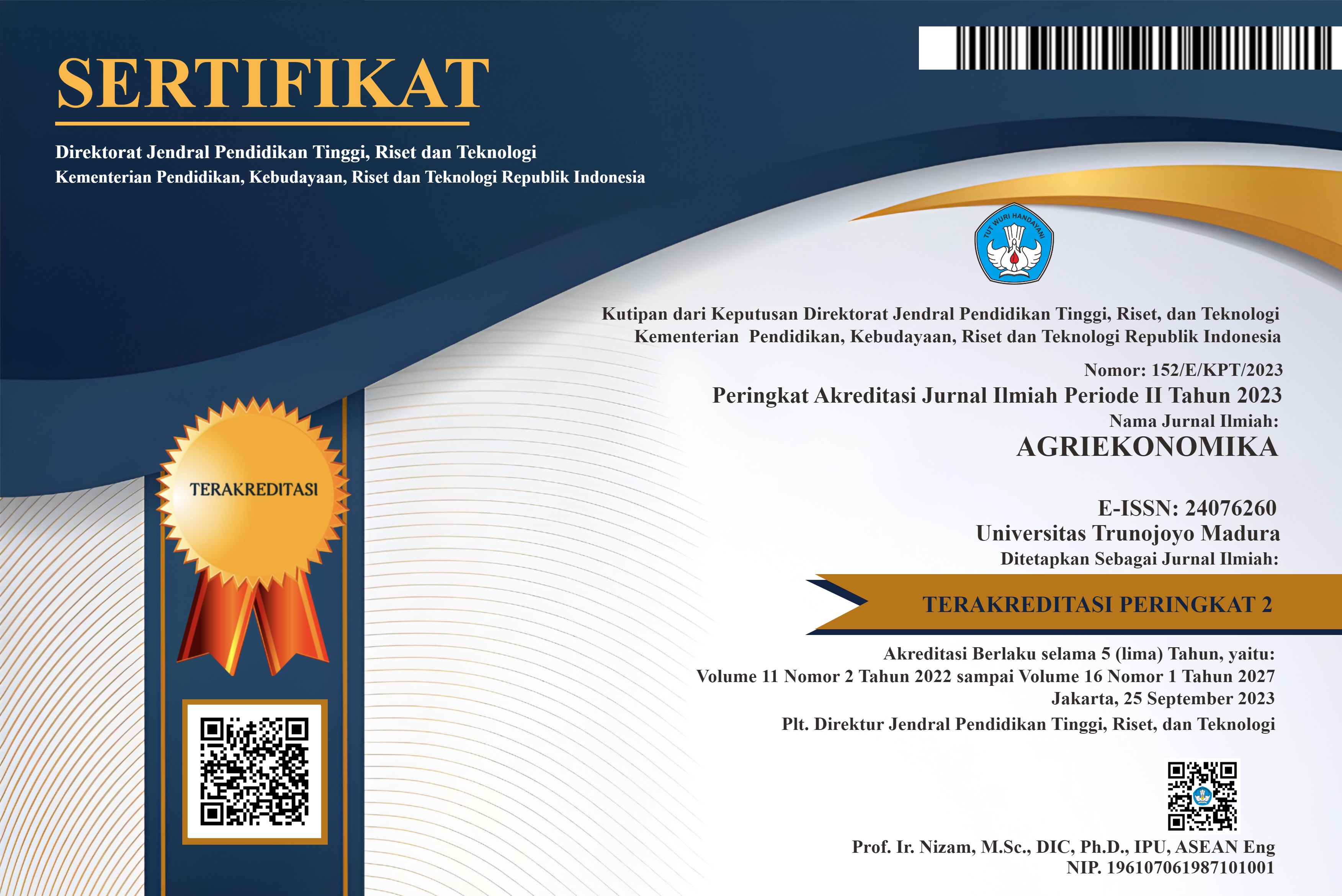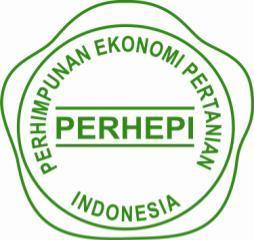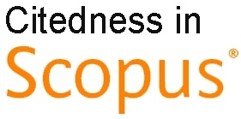AGRO-ECOLOGICAL AND SOCIO-ECONOMIC ASPECTS OF CROP PROTECTION IN CHILI-BASED AGRIBUSINESS IN CENTRAL JAVA
Abstract
The purpose of this study is to analyze the socio-economic and agro-ecological aspects of chili production in three selected communities of three districts —Magelang, Brebes, and Rembang—that represent distinct agro-ecosystems of chili cultivation within Central Java province. This is to answer a problem statement that chili farming still faces crop protection aspects as limiting factors in chili production. This study uses quantitative descriptive methods. Data were compiled from a survey of 160 chili farmers in 2010-2011. The results show that yield loss due to pests and diseases was considerable, and some of these problems were becoming difficult to control. The three top pests were thrips, mites, and whitefly; and the top three diseases were Anthracnose, Gemini-viruses, and Phytophthora. During the wet season, risk of anthracnose was very high; in the dry season, risk of yield lost to Gemini-viruses and Phytophthora was high. The potential losses could reach 100%. There is a crucial need to solve the problems by enhancing farmers’ knowledge and involving research institutions focusing on crop protection strategy.
Keywords
Full Text:
PDFReferences
Bank of Indonesia. (2007). Lending Model Information System for Small-Scale Enterprises: Medicinal Plant Cultivation. Jakarta.
Bhattarai, M., & Mariyono, J. (2016). The economic aspects of chilli production in Central Java. Economic Journal of Emerging Markets, 8(2), 85–97. https://doi.org/10.20885/ejem.vol8.iss2.art1
BPS. (2015). Statistik Indonesia. Jakarta: Badan Pusat Statistik. Retrieved from www.bps.go.id
FAOSTAT. (2009). FAOSTAT Online. Retrieved March 20, 2010, from http://faostat.fao.org/default/aspx?lang-en
Herison, C., Rustikawati, & Sudarsono. (2007). Aktivitas Peroksidase, Skor ELISA dan Respon Ketahanan 29 Genotipe Cabai Merah Terhadap Infeksi Cucumber Mosaic Virus (CMV). Akta Agrosia, 10(1), 1–13.
Irawan, B. (2007). Fluktuasi Harga, Transmisi Harga dan Marjin Pemasaran Sayuran dan Buah. Analisis Kebijakan Pertanian. Analisis Kebijakan Pertanian, 5(4), 358–373.
Kuntariningsih, A., & Mariyono, J. (2013a). Dampak Pelatihan Petani Terhadap Kinerja Usahatani Kedelai Di Jawa Timur. Sosiohumaniora, 15(2), 139–150. https://doi.org/10.24198/sosiohumaniora.v15i2.5739
Kuntariningsih, A., & Mariyono, J. (2013b). Socio-Economic Factors Affecting Adoption of Hybrid Seeds and Silvery Plastic Mulch. Jurnal Sosial Ekonomi Pertanian Dan Agribisnis, 9(2), 279–308.
Luther, G., Palada, M., Wang, T. C., Dibiyantoro, A., Mariyono, J., Ameriana, M., … Bimantoro. (2007). Chili Integrated Disease Management Rural Appraisal in Central Java. Integrated Disease Management (IDM) for Anthracnose, Phytophthora blight, and Whitefly Transmitted Gemini-viruses in Chili Pepper in Indonesia. Taiwan.
Mariyono, J. (2008). Direct and indirect impacts of integrated pest management on pesticide use: A case of rice agriculture in Java, Indonesia. Pest Management Science, 64(10), 1069–1073. https://doi.org/10.1002/ps.1602
Mariyono, J. (2008a). Dynamic Model of Pest Attacks and Pesticide Use: Optimal Pest Control in Plant Protection. International Journal of Ecological Economics and Statistics, 10(8), 5–18.
Mariyono, J. (2008b). National Dissemination of Integrated Pest Management Technology through Farmers’ Field Schools in Indonesia: Was It Successful? Journal of Agricultural Technology, 4(1), 11–26.
Mariyono, J. (2008c). The Impact of Integrated Pest Management Technology on Insecticide Use in Soybean Farming in Java, Indonesia: Two Models of Demand for Insecticides. Asian Journal of Agriculture and Development, 5(1), 43–56.
Mariyono, J. (2015). Green revolution- and wetland-linked technological change of rice agriculture in Indonesia. Management of Environmental Quality: An International Journal, 26(5), 683–700. https://doi.org/10.1108/MEQ-07-2014-0104
Mariyono, J. (2016a). Impacts Seed Technology Improvement on Economic Aspects of Chilli Production in Central Java - Indonesia. Jurnal Ekonomi Pembangunan: Kajian Masalah Ekonomi Dan Pembangunan, 17(1), 1–14. https://doi.org/10.23917/jep.v17i1.1453
Mariyono, J. (2016b). Integrated Disease Management for Chili Farming in Brebes and Magelang - Central Java: Social Economic Impacts. Agriekonomika, 5(2), 114–124.
Mariyono, J. (2017). Moving to commercial production: a case of intensive chili farming in Indonesia. Development in Practice, 27(8), 1103–1113. https://doi.org/10.1080/09614524.2017.1360841
Mariyono, J., & Bhattarai, M. (2011). Revitalizing Indonesian Rural Economy through Intensive Farming of High Value Vegetables: A Case Of Chili Farming In Central Java. In B. P. Afianto, B.E.; Yusuf, A.A.; Resosudarmo (Ed.), Indonesia’s Regional Economy in the Globalization Era. IRSA Book Series on Regional Development No. 9 (pp. 71–89). Surabaya.
Mariyono, J., Kuntariningsih, A., Dewi, H. A., Latifah, E., Daroini, P. B., Negoro, A. A., … Luther, G. (2017). Pathway analysis of vegetable farming commercialization. Economic Journal of Emerging Markets, 9(2), 115–124. https://doi.org/10.20885/ejem.vol9.iss2.art1
Mariyono, J., & Negoro, A. A. (2016). Impact of Farmers’ Knowledge on Joint Productions of Rice and Soybean in Central Java, Indonesia. Journal Animal Science and Agronomy Panca Budi, 1(1), 7–16.
Mariyono, J., & Sumarno, S. (2015). Chilli production and adoption of chilli-based agribusiness in Indonesia. Journal of Agribusiness in Developing and Emerging Economies, 5(1), 57–75. https://doi.org/10.1108/jadee-01-2014-0002
Mustafa, U., Ali, M., & Kuswanti, H. (2006). Indonesia. In M. Ali (Ed.), Chili (Capsicum spp.) Food Chain Analysis: Setting Research Priorities in Asia (p. 253). Taiwan: AVRDC - The World Vegetable Center.
Negoro, A. A., & Mariyono, J. (2014). Peran Sistem Informasi Dan Teknologi Luar Musim Dalam Bisnis Berbasis Komoditas Sayuran. In Prosiding Seminar Nasional PERHORTI 2014. Malang: PERHORTI.
Pamekas, T. (2007). Potensi Ekstrak Cangkang Kepiting untuk Mengendalikan Penyakit Pascapanen Antraknosa pada Buah Cabai Merah. Akta Agrosia, 10(1), 72–75.
Rahman, S. (2003). Farm-Level Pesticide Use in Bangladesh: Determinants and Awareness. Agriculture, Ecosystems and Environment, 95(1), 241–252.
Selvarajah, A., & Thiruchelvam, S. (2007). Factors Affecting Pesticide Use by Farmers in Vavuniya District. Tropical Agricultural Research, 19(1), 380–388.
Sugiarti, S. (2003). Usahatani dan Pemasaran Cabai Merah di Kabupaten Rejang Lebong. Akta Agrosia, 6(1), 30–34.
DOI: https://doi.org/10.21107/agriekonomika.v6i2.2294
Refbacks
- There are currently no refbacks.







